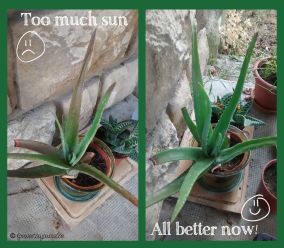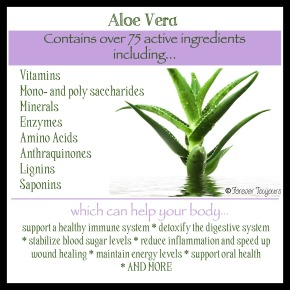 Most people today have heard of Aloe Vera. The aloe market is estimated to be a $13 billion industry with products ranging from shampoos and face creams to drinking gels and laxatives. You may have used it to soothe your sun-damaged skin after spending too much time at the beach this summer. Or, like me, to help soothe the blisters on your chicken-pocked (poxed?) son.
Most people today have heard of Aloe Vera. The aloe market is estimated to be a $13 billion industry with products ranging from shampoos and face creams to drinking gels and laxatives. You may have used it to soothe your sun-damaged skin after spending too much time at the beach this summer. Or, like me, to help soothe the blisters on your chicken-pocked (poxed?) son.
Aloe is more than a burn (or chicken pox) balm. It has been used as a medicinal plant for over 4000 years (read my synopsis of aloe’s healing history here). It has been dubbed a “miracle plant” because it contains so many healthy compounds within its clear gel. Mike Adams of NaturalNews.com thinks it’s the best herb out there. In our house we have used it to treat conditions, literally, from head (lice infestation) to toe (blisters) and many places in between (skin, gums, joints, guts…).
The plant itself is as beautiful as it is useful. Leaves of the plant develop in a spirally, pattern. They can be as short as 2.5 inches or as tall as 4 feet. I have a potted plant on my front porch and the largest leaf is about 15 inches now. Because it’s in a small pot, it’s unlikely to get much bigger… …but, when we were in California this past winter, some of our neighbors had giant plants! Fully grown plants like these from the Forever Living plantation usually have between 12 and 16 leaves that may weigh up to three pounds!
…but, when we were in California this past winter, some of our neighbors had giant plants! Fully grown plants like these from the Forever Living plantation usually have between 12 and 16 leaves that may weigh up to three pounds!

There are over 350 different varieties of aloe in the world (the name comes from “Alloeh” meaning “shining bitter substance” in Arabic). The one we commonly call aloe vera (“vera” means “true” in Latin) is Aloe barbadensis Miller. All the aloe varieties are members of the tree lily family so they are more closely related to tiger lilies and medicinal plants such as garlic and asparagus than they are to the succulent cacti that they resemble (find more fascinating aloe trivia here).
The gel or pulp of Aloe barbadensis Miller contains over 75 active components including:
- Vitamins such as A, B1, B6, B12, C, E, and folic acid
- Minerals such as calcium, selenium, magnesium, potassium, and zinc
- 20 of the 22 amino acids (including 7 of the 8 essential amino acids that we can only get from food sources and cannot produce ourselves)
- And many more that you can find listed here.
These active components have been identified as playing a role in anti-inflammatory, anti-bacterial, anti-tumor, anti-aging, etc. Basically, they do lots and lots of good stuff.
 Of course, these benefits weren’t designed with us in mind. The aloe plant evolved to protect itself from the harsh, tropical environments of equatorial Africa in which it originated. I accidentally experienced this first hand this summer, when I gave my aloe plant a sunburn. After moving it into a shadier part of my deck and giving it water and a few days, it healed itself!
Of course, these benefits weren’t designed with us in mind. The aloe plant evolved to protect itself from the harsh, tropical environments of equatorial Africa in which it originated. I accidentally experienced this first hand this summer, when I gave my aloe plant a sunburn. After moving it into a shadier part of my deck and giving it water and a few days, it healed itself!
Similarly, veterinarians have been using aloe vera on their animal patients for over a century. When the Royal College of Veterinary Surgeons in the UK was granted a royal charter in 1844, aloe was such a well-used treatment that it was put onto the coat of arms (on the shield being carried by the centaur).
Back to us humans. The medical literature is starting to catch up with the public’s renewed excitement over this plant.  New studies are coming out, literally, as I type this about the role aloe can play in the treatment of diseases like cancer, diabetes, infections (these 3 studies have come out in the past few weeks!), plus gum disease, psoriasis, ulcerative cholitis, wound healing, and many others.
New studies are coming out, literally, as I type this about the role aloe can play in the treatment of diseases like cancer, diabetes, infections (these 3 studies have come out in the past few weeks!), plus gum disease, psoriasis, ulcerative cholitis, wound healing, and many others.
Aloe’s health benefits are numerous and clearly have been tested over a long history and across many cultures. The medical literature backs up the oral reports. Four thousand years of evidence can’t be wrong. The plant has restorative properties that supports both our bodies’s external and internal wellbeing.
Look, do I think aloe is the “miracle cure”? Will it help me be immortal as the Ancient Egyptians believed? Well, obviously not. No one lives forever. But do I believe aloe can be part of living my healthiest, happiest life? Absolutley!
Aloe vera helped me get through a severe bout of acid reflux. The symptoms were a wake up call that I needed to make changes to my lifestyle and reduce stress. I had to change my eating habits: no more eating on the run or wolfing down food. I am learning how to be more mindful about my relationship with food. And I am taking more time for self-care and exercise. Aloe was part of those changes and, honestly, I believe an integral part.
Click here to learn more about how not all aloe products on the market are the same.

Pingback: Why I’m not stressing about bacon | Forever Toujours Aloe